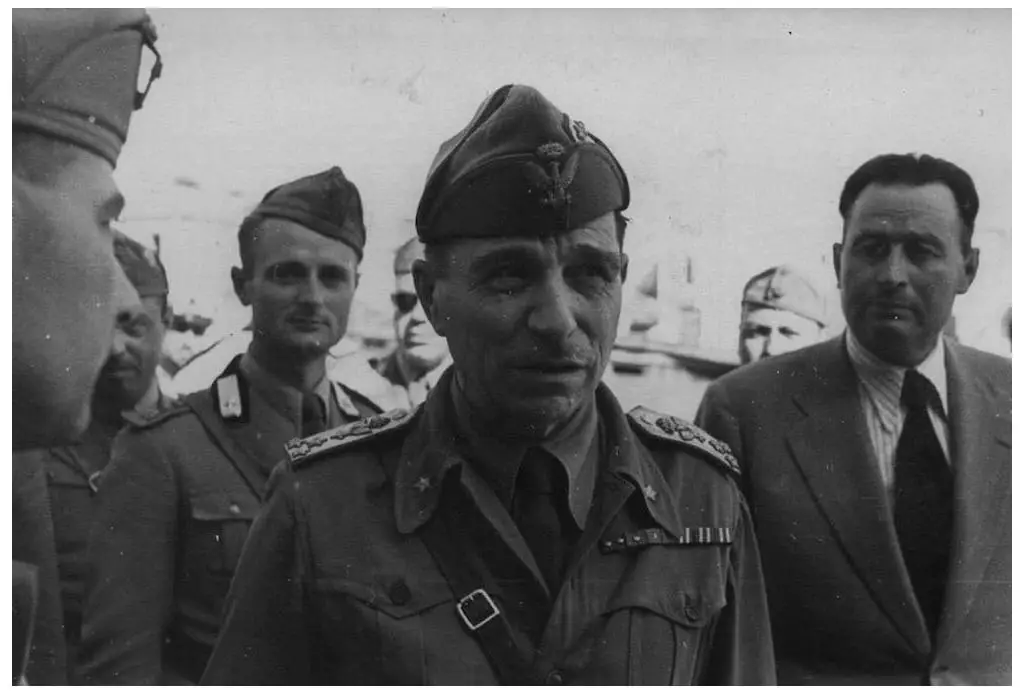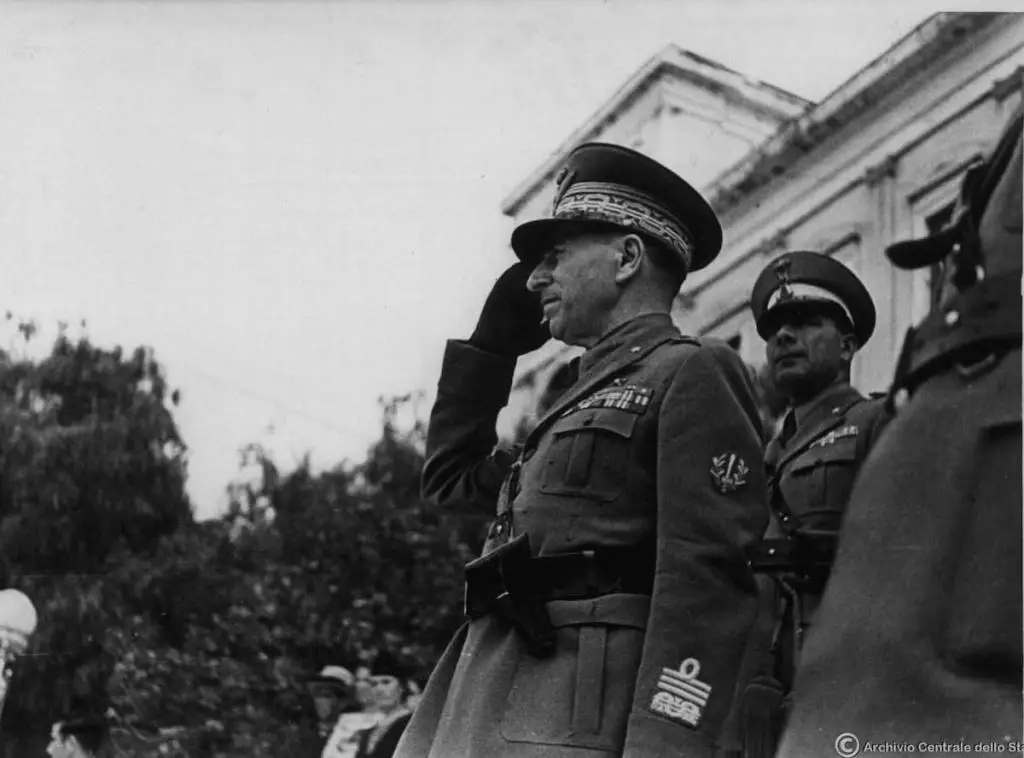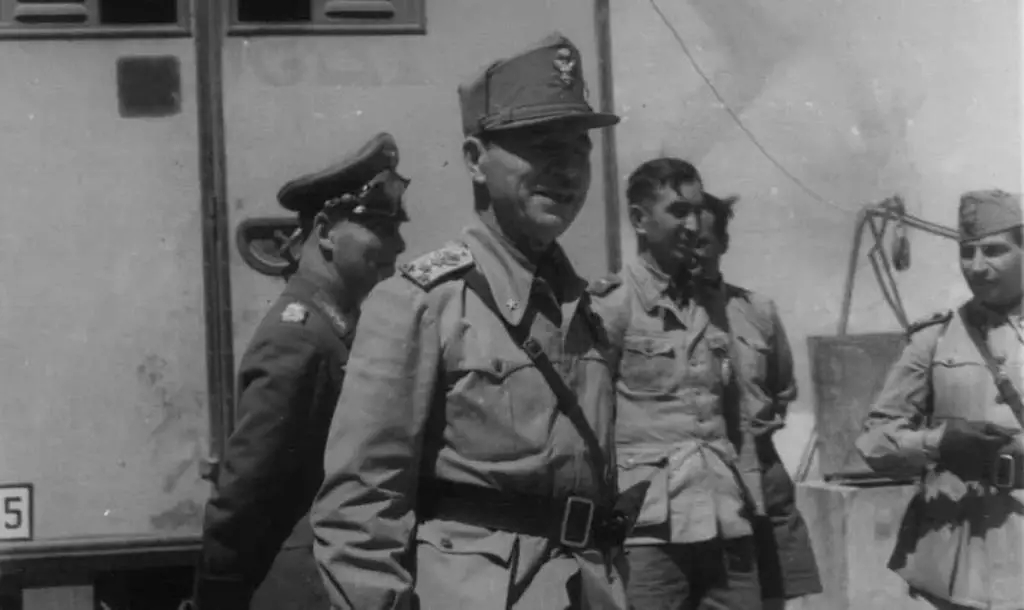Background on Ettore Bastico
The life of Ettore Bastico began on April 9th, 1876, in Bologna, Emilia-Romagna, Italy. Ettore Bastico eventually entered military school at the age of 18, in 1894. This marked the beginning of a long military career, a history of service spanning three different governments and five wars. He dedicated most of his life to military service, fighting in every 20th-century conflict that Italy faced. Ettore Bastico first fought in the Italo-Turkish War, serving in the First World War a few years later. Here, he won numerous decorations for his distinguished service. He rose through the ranks during the interwar period and developed a close friendship with Benito Mussolini.

General Ettore Bastico in Crete, spring 1941. Image credit: Archivio Centrale dello Stato.
During the interwar years, he wrote ‘The Evolution of the Art of War’, his perspective on the future of warfare. He came into conflict with the visionary, Giulio Douhet; a key point of difference was the mechanization of warfare. Giulio Douhet’s predictions were perhaps too advanced, expecting the human element of warfare to decline altogether. This overestimation of the new machines was at times inaccurate, and Bastico was correct in assessing the human element of warfare. However, he also lacked the imagination to realize the true potential of tanks and the mobile nature of future wars.
Early Service and Military Ideas
After commanding tanks in Spain, he recognized the tank as a formidable infantry support weapon. However, he also wrote, “let us not idolize it, let us reserve our reverence for the infantryman and the mule.” It was a sensible attitude for mountain warfare, which Italy spent the era preparing for. However, they reflect the same attitudes contributing to poor preparation for the desert warfare that Italy found itself fighting.
Perhaps due to his experience in the trenches, his strategic sensibilities tended towards the conservative side. This trait would contribute to personality conflicts between himself and Erwin Rommel during the Second World War. However, his prior commands displayed good leadership qualities and energy on the offensive.
He first fought in Ethiopia, leading the 1st Blackshirt Division (23 Marzo). The 1st Blackshirt served on the Eritrean front on the march towards Addis Ababa. There, they played a part in the destruction of the main Ethiopian armies.
Spanish Civil War
The greatest personal success of Ettore Bastico would come a few years later, however, during his brief tenure with the Corpo Truppe de Voluntarie (CTV). The CTV represented the Italian land forces serving with Franco and the Spanish Nationalists.
During the critical year of 1937, Francisco Franco found it essential to defeating the Republicans quickly. While the Nationalists were better equipped for the time, the Republicans enjoyed a numerical advantage. Their hope was to hold onto Madrid and the isolated Northern front until the winter. This done, their great reserve Army of Maneuver could crush the thin Nationalist defensive lines.

General Ettore Bastico visits Syros during the summer of 1941. Image: Archivio Centrale dello Stato.
Rebuilding the Corpo Truppe de Volontarie
The Republican forces inflicted a serious defeat on the CTV at the Battle of Guadalajara, saving Madrid in the process. Under Mario Roatta, the Italian troops performed quite poorly. But two factors spelled doom for the Republican cause, in 1937. Those factors being Franco’s shift in strategy, and Ettore Bastico rising to command of the CTV.
Franco decided to eliminate the isolated Northern Front, and Ettore Bastico reorganized the CTV. He stripped out unreliable units and formed two effective divisions under his best officers in preparation. A far cry from the CTV of Guadalajara, these two divisions were the most powerful force on the Nationalist side.
During the Battle of Santander, the new, leaner CTV fought a bloody offensive battle through the mountains. They played the lead role in that battle, piercing deep into Republican lines and securing a key mountain pass. The Republican forces fell into retreat, their disaster completed by the Pact of Santoña.
The ethnic Basque forces of the Republic were fighting not for it, but for the Basque territory, which had just been lost. As a result, a subordinate of Bastico signed the Pact of Santoña with the Basque forces. In exchange for protecting them from Franco and becoming Italian POW’s, 22,000 Basque soldiers surrendered. Their loss caused the collapse of the Republican position and the destruction of the Northern Front. Many Nationalist divisions were made available to reinforce the main front, and the grand Republican offensive never materialized.
In spite of his debt to the CTV, Franco disregarded the Pact of Santoña and imprisoned the Basque soldiers, executing many of them. Franco dishonoring the agreement sparked personality conflicts between himself and the hard-headed Bastico, who Franco demanded replaced.
Service In the Second World War
His service in Spain complete, Ettore Bastico moved between many commands in the following year. He temporarily led the motorized ‘Army of the Po Valley’, and also served as military governor of the Dodecanese Islands. On July 19, 1941, Ettore Bastico gained the position of overall commander of forces in North Africa, but his control was nominal. The most important force under his command, the German-Italian mechanized force, often disregarded his control and considered Rommel as the de-facto commander. Bastico and Rommel found each other impossible to deal with, and Rommel eventually bypassed Bastico and gained permission to contact Comando Supremo directly. In doing so, Bastico was effectively cut from the chain of command.

General Ettore Bastico with Erwin Rommel in the spring of 1942. Image credit: Centro Archivio dello Stato.
Rommel’s disrespect for his authority often angered Bastico, while Rommel found Bastico, who he nicknamed ‘Bombastico‘, insufferable. Furthermore, they often disagreed on military matters. Bastico had the unenviable task of restraining the Desert Fox, but his conservative judgments often proved correct. Rommel’s Dash to the Wire left the Panzerkorps in quite a bad shape, and lead to British victory in Operation Crusader. At Gazala, Bastico urged caution. However, Rommel’s aggression and frontline leadership won a spectacular victory there, and this is beyond dispute. However, his pursuit of British forces, against Bastico’s urging to attack Malta was arguably a critical mistake. Malta’s revival as an offensive base posed dire consequences, and Rommel had trapped himself beyond his supply lines at El Alamein.
Bastico was promoted to Marshal of Italy on August 12, 1942, so as not to be junior tin rank to Rommel .
After North Africa
The defeats at sea and on land during 1942-1943 lead to a steady retreat, and the capitulation of Axis forces in Tunisia in 1943. Field Marshal Ettore Bastico was left with no command and spent the duration of the war without orders. He remained in service with the postwar Italian Army until his retirement in 1947, bringing a 53-year long military career to a close. He died of heart failure on December 1, 1972, at the age of 96.
